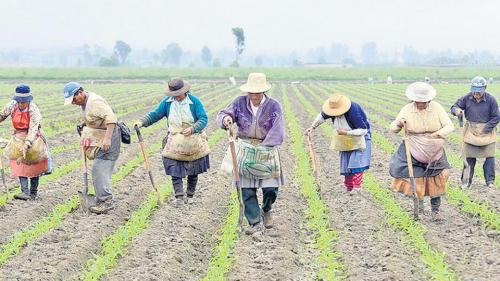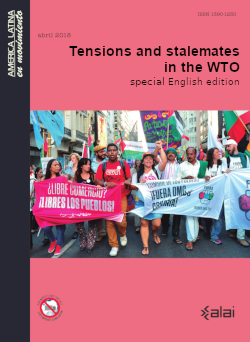Inequitable WTO rules in Agriculture
The issue of subsidies has remained the most controversial in WTO agricultural negotiations.
- Opinión

| Article published in ALAI’s magazine No. 532: Tensions and stalemates in the WTO 24/06/2019 |
The World Trade Organisation (WTO) was established in 1995 to create an open, non-discriminatory and transparent multilateral trading system that would enable developing countries to “catch up” on development objectives. Agriculture, in particular, was offered as an area that would enable developing and least developed countries to access additional export markets as it was seen as an area of competitive advantage for them. Special and differential treatment for developing countries had been promised even before the WTO was born, and the Doha Development Round (DDR) of 2001 further underpinned this principle.
However, 23 years after the formation of the WTO, the promises remain unrealised. The three major pillars of agricultural trade negotiations, embodied in the Agreement on Agriculture(AOA) and supported by other agreements, are; market access or the reduction of border duties; elimination of export subsidies or other forms of export support; and reduction/elimination of trade distorting domestic support. The Subsidy issue remains key for global agricultural trade as it benefits those receiving such subsidies over those farmers who do not. It is clear that this discriminates against farmers in poorer countries who receive much less support, both export and domestic, from their poorer governments.
WTO Negotiations on Agriculture
In the WTO, while the 1st pillar of the AOA imposed maximum duties to be notified and bound by Member States, negotiations to actually cut these bound (maximum rates) have not progressed much, mainly because of the relative stagnation in the last and key pillar of domestic support.
It is the issue of subsidies that has remained the most controversial in WTO agricultural negotiations. An agreement to eliminate export measures was finally reached in Nairobi Ministerial in 2015, even if on terms to appease the US. But though export subsidies directly distort global trade, also by going to agribusiness rather than to individual farmers, export subsidies have been decreasing and ceased to be the most important element of subsidies.
Domestic support has, however, been another matter. The AOA had clubbed domestic support into 3 boxes. Of the two most important of these, the Amber Box includes trade-distorting subsidies which were to be cut, except for a De Minimis of 5% and 10% of the Value of Production (VOP) as product-specific allowance for developed and developing countries respectively (with another 5 and 10% of VOP as non-product specific (general) allowance). The second important one is the Green Box which includes non-trade distorting subsidies which could be given without limit.
However in manifestation of the inequity that underpins WTO’s AOA, the developed countries were allowed an extra entitlement over the 5% of VOP and this amounts, for example, to 19 billion, 37.5 billion and 95 billion for USD for the US, Japan and EU respectively. Further, the developed countries did not meet their promise of cutting Amber Box subsidies apart from the 5% De minimis and the extra entitlements. Finally, they have indulged in so-called “box-shifting” by moving trade-distorting subsidies in the Amber Box to the Green Box and therefore escaping reduction commitments. But evidence shows such large GB subsidies have distorted trade and hurt poor farmers across developing countries.
Between 1995-2013, domestic subsidies (including Green Box) in the US increased from 65 billion USD to 146.8 billion USD, and that of EU it remained more or less constant around 130.4 billion USD. Of these figures, EU GB subsidies stand at 68.7 billion Euros while that of the US is 124.5 billion USD in 2014. Overall OECD subsidies increased from 350 billion USD to 400 Billion USD over this period.
The Food Security Proposal
However as if this was not unfair enough, recent debates in the WTO has targeted developing country subsidies, in particular subsidies given as administered price support to farmers through public food programmes. Many governments use such programmes and use it to subsidise both producers and consumers. However the AOA terms the price support to farmers as trade distorting and therefore subjects it to the 10% de minimis limit. Moreover, this subsidy (calculated as the difference between administered price and global market price) is calculated at a fixed 1986-88 market price when global prices were at one of the lowest due to dumping by US and EU. This naturally overestimates the subsidy which, in reality, should be calculated from the current market price.
Interestingly, a quick look at per farmer subsidies show the EU gives 12,384 USD, Japan 14,136 USD, while the US gives 68,910 USD. Compared to that China gives 348 USD, India 228 USD, Brazil 468 USD and, Indonesia 73 USD, per farmer[i].
Not surprisingly, several countries including India, Indonesia, China, Kenya, Egypt, Turkey,
Morocco, Tunisia, Jordan and others have been close to reaching the 10% level given this artificial calculation method. Many of them have been called out by developed countries including the US, EU and Canada for violating WTO limits. Before the Bali Ministerial of 2013, the G-33 group of developing countries brought in “the Food Security Proposal on Public Food Stockholding” to argue that such subsidies, meant for poor farmers in developing and least developed countries, should be allowed under the Green Box to be given without limit.
In Bali, after much tussle and a heavy payment with the Trade Facilitation Agreement (TFA)[ii], the developing countries managed to get a Peace Clause (PC), which excused them from litigation even if the subsidy limit was breached. However, the PC came with onerous conditionalities such as heavy transparency and notification requirements (which is not needed for use of Green Box) difficult to meet by developing countries, as well as meeting umbrella conditions such as “non-trade-distorting” and not impacting “food security” of other countries. The PC was indeed designed to fail in practice. Further it was limited to existing programmes at the time of this agreement in December 2013.
Negotiations at Buenos Aires Ministerial 2017
Realising the PC is inadequate to cover their farmers’ needs, the G-33 has pushed on for a Permanent Solution which is less onerous and more effective. However despite a mandate to deliver this Permanent Solution by the Buenos Aires Ministerial of December 2017, there was no progress and at the end no outcome on this. The US flatly refused to grant any Permanent Solution in any form at the beginning of the Ministerial.
In fact there was not much hope for an effective and farmer-friendly PS even before the Ministerial. Alternative proposals that were advanced in Geneva to the G-33 proposal from countries such as EU, Brazil, Argentina, Russia, US argued for more onerous transparency and safeguard conditions. There was also an attempt to link the permanent solution with other issues in agriculture such as domestic subsidy disciples on developed country subsidies, but also with new issues such as domestic regulation in services, e-commerce and so on. It was clear that developing countries will have to pay a heavy price again for a PS that was worth any value to them.
At the same time, a proposal by India and China before the Buenos Aires Ministerial that asked developed countries to discipline their extra subsidy entitlements reached nowhere. Several proposals by developed countries suggested if cuts had to be made to domestic subsidies, then all, including developing countries, should make cuts. Even the Development Box, or a special subsidy that is allowed to developing countries as special and differential treatment to give input subsidies, was asked to be disciplined.
Another proposal by developing countries that has been lamenting for a long time is on Special Safeguard Mechanism that asks that in order to protect farmers’ livelihoods in case of an import surge[iii] developing countries be allowed to raise import duties beyond the notified WTO Bound Duties. But this too has seen no result until now.
There was no proposal to discipline the Green Box in spite of ample evidence to show its trade distorting impact.
Towards the Future
Standing in early 2018 and looking at the failure of the Buenos Aires Ministerial to deliver anything meaningful on agriculture, what does the current scenario imply for farmers across the developing world?
Farmers will continue to face unfair price competition from subsidised products from developed countries in their own as well export markets but will be unable to meet standard barriers. Further, their own subsidies that they may have fought hard for in a domestic arena, will also be challenged by WTO rules and the current PC does not really offer them a reprieve against it. In fact they stand at the risk of losing even the meagre development subsidies in terms of input support that their governments can currently provide.
The stalemate of the Doha Round and the refusal of rich countries like the US to conclude the DDR also means that the special and differential treatment in duty cuts, subsidies and other rules are all uncertain indicating grave risks for farmers’ livelihoods and farming & food security in developing countries. Further, the new issues that are being pushed heavily in the WTO such as investment facilitation, government procurement and e-commerce pose new challenges for the agricultural sector in terms of increasing threats from land and resource grab, entry of MNCs in government food programmes, control of agricultural production and consumption by e-companies, and escalating control of agricultural technologies by corporations.
Given the history of such inequitable agricultural trade rules at the WTO, it is no surprise that several farmers’ groups across developing countries have called for “agriculture (to be) out of WTO”. However, subsidies can be discussed and disciplined only at the WTO while developing countries are being forced to give up applied import duties in the Free Trade Agreements. In a bizarre twist, the developed countries who pushed on the agricultural agreement, now do not want to talk about progressive reforms to the highly unfair agricultural rules in the WTO. Developing countries have no choice but to fight for it.
Ranja Sengupta works with Third World Network as Senior Researcher and is based in New Delhi, India. She has been researching on trade and investment policies with specific focus on development, including on agriculture and food security.
[i] Sengupta Ranja (2017), “The road to Buenos Aires, December 2017: Agriculture remains key”, TWN Briefing Paper 95, November
[ii] The TFA is a permanent agreement on border measures that benefits mainly developed countries.
[iii] A sudden surge in volume of imports or a fall in prices brought on by rising imports.
Del mismo autor
Clasificado en
Soberanía Alimentaria
- Gerson Castellano, Pedro Carrano 30/03/2022
- Silvia Ribeiro 29/03/2022
- Germán Gorraiz López 28/03/2022
- Silvia Ribeiro 16/02/2022
- Clara Sánchez Guevara 15/02/2022

